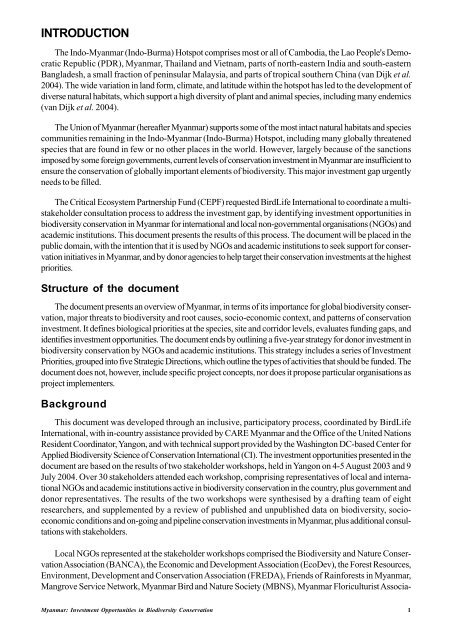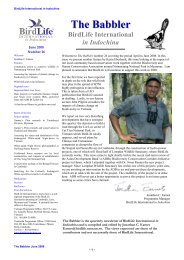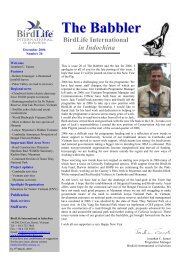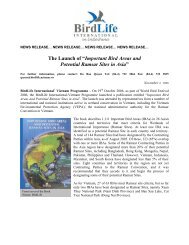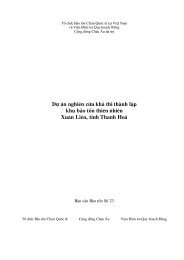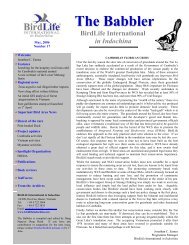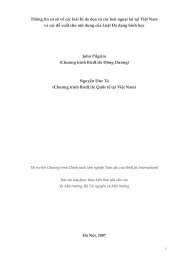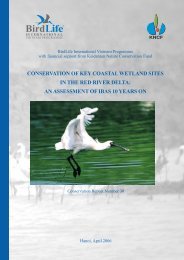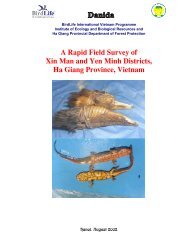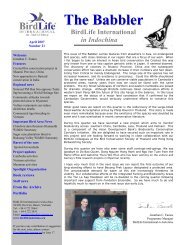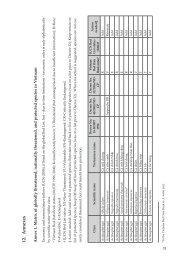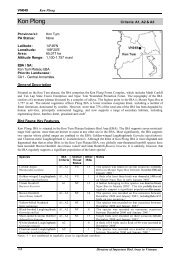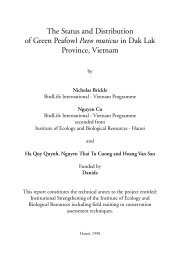Myanmar: Investment Opportunities in Biodiversity Conservation
Myanmar: Investment Opportunities in Biodiversity Conservation
Myanmar: Investment Opportunities in Biodiversity Conservation
You also want an ePaper? Increase the reach of your titles
YUMPU automatically turns print PDFs into web optimized ePapers that Google loves.
INTRODUCTION<br />
The Indo-<strong>Myanmar</strong> (Indo-Burma) Hotspot comprises most or all of Cambodia, the Lao People's Democratic<br />
Republic (PDR), <strong>Myanmar</strong>, Thailand and Vietnam, parts of north-eastern India and south-eastern<br />
Bangladesh, a small fraction of pen<strong>in</strong>sular Malaysia, and parts of tropical southern Ch<strong>in</strong>a (van Dijk et al.<br />
2004). The wide variation <strong>in</strong> land form, climate, and latitude with<strong>in</strong> the hotspot has led to the development of<br />
diverse natural habitats, which support a high diversity of plant and animal species, <strong>in</strong>clud<strong>in</strong>g many endemics<br />
(van Dijk et al. 2004).<br />
The Union of <strong>Myanmar</strong> (hereafter <strong>Myanmar</strong>) supports some of the most <strong>in</strong>tact natural habitats and species<br />
communities rema<strong>in</strong><strong>in</strong>g <strong>in</strong> the Indo-<strong>Myanmar</strong> (Indo-Burma) Hotspot, <strong>in</strong>clud<strong>in</strong>g many globally threatened<br />
species that are found <strong>in</strong> few or no other places <strong>in</strong> the world. However, largely because of the sanctions<br />
imposed by some foreign governments, current levels of conservation <strong>in</strong>vestment <strong>in</strong> <strong>Myanmar</strong> are <strong>in</strong>sufficient to<br />
ensure the conservation of globally important elements of biodiversity. This major <strong>in</strong>vestment gap urgently<br />
needs to be filled.<br />
The Critical Ecosystem Partnership Fund (CEPF) requested BirdLife International to coord<strong>in</strong>ate a multistakeholder<br />
consultation process to address the <strong>in</strong>vestment gap, by identify<strong>in</strong>g <strong>in</strong>vestment opportunities <strong>in</strong><br />
biodiversity conservation <strong>in</strong> <strong>Myanmar</strong> for <strong>in</strong>ternational and local non-governmental organisations (NGOs) and<br />
academic <strong>in</strong>stitutions. This document presents the results of this process. The document will be placed <strong>in</strong> the<br />
public doma<strong>in</strong>, with the <strong>in</strong>tention that it is used by NGOs and academic <strong>in</strong>stitutions to seek support for conservation<br />
<strong>in</strong>itiatives <strong>in</strong> <strong>Myanmar</strong>, and by donor agencies to help target their conservation <strong>in</strong>vestments at the highest<br />
priorities.<br />
Structure of the document<br />
The document presents an overview of <strong>Myanmar</strong>, <strong>in</strong> terms of its importance for global biodiversity conservation,<br />
major threats to biodiversity and root causes, socio-economic context, and patterns of conservation<br />
<strong>in</strong>vestment. It def<strong>in</strong>es biological priorities at the species, site and corridor levels, evaluates fund<strong>in</strong>g gaps, and<br />
identifies <strong>in</strong>vestment opportunities. The document ends by outl<strong>in</strong><strong>in</strong>g a five-year strategy for donor <strong>in</strong>vestment <strong>in</strong><br />
biodiversity conservation by NGOs and academic <strong>in</strong>stitutions. This strategy <strong>in</strong>cludes a series of <strong>Investment</strong><br />
Priorities, grouped <strong>in</strong>to five Strategic Directions, which outl<strong>in</strong>e the types of activities that should be funded. The<br />
document does not, however, <strong>in</strong>clude specific project concepts, nor does it propose particular organisations as<br />
project implementers.<br />
Background<br />
This document was developed through an <strong>in</strong>clusive, participatory process, coord<strong>in</strong>ated by BirdLife<br />
International, with <strong>in</strong>-country assistance provided by CARE <strong>Myanmar</strong> and the Office of the United Nations<br />
Resident Coord<strong>in</strong>ator, Yangon, and with technical support provided by the Wash<strong>in</strong>gton DC-based Center for<br />
Applied <strong>Biodiversity</strong> Science of <strong>Conservation</strong> International (CI). The <strong>in</strong>vestment opportunities presented <strong>in</strong> the<br />
document are based on the results of two stakeholder workshops, held <strong>in</strong> Yangon on 4-5 August 2003 and 9<br />
July 2004. Over 30 stakeholders attended each workshop, compris<strong>in</strong>g representatives of local and <strong>in</strong>ternational<br />
NGOs and academic <strong>in</strong>stitutions active <strong>in</strong> biodiversity conservation <strong>in</strong> the country, plus government and<br />
donor representatives. The results of the two workshops were synthesised by a draft<strong>in</strong>g team of eight<br />
researchers, and supplemented by a review of published and unpublished data on biodiversity, socioeconomic<br />
conditions and on-go<strong>in</strong>g and pipel<strong>in</strong>e conservation <strong>in</strong>vestments <strong>in</strong> <strong>Myanmar</strong>, plus additional consultations<br />
with stakeholders.<br />
Local NGOs represented at the stakeholder workshops comprised the <strong>Biodiversity</strong> and Nature <strong>Conservation</strong><br />
Association (BANCA), the Economic and Development Association (EcoDev), the Forest Resources,<br />
Environment, Development and <strong>Conservation</strong> Association (FREDA), Friends of Ra<strong>in</strong>forests <strong>in</strong> <strong>Myanmar</strong>,<br />
Mangrove Service Network, <strong>Myanmar</strong> Bird and Nature Society (MBNS), <strong>Myanmar</strong> Floriculturist Associa-<br />
<strong>Myanmar</strong>: <strong>Investment</strong> <strong>Opportunities</strong> <strong>in</strong> <strong>Biodiversity</strong> <strong>Conservation</strong><br />
1


